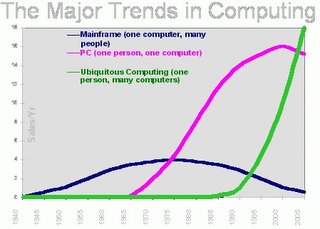
"The most profound technologies are those that disappear. They weave themselves into the fabric of everyday life until they are indistinguishable from it". --Mark Weiser
"The third wave of computing is that of ubiquitous computing, whose cross-over point with personal computing will be around 2005-2020". --MW, JSB
Ubiquitous computing
"Ubiquitous computing names the third wave in computing, just now beginning. First were mainframes, each shared by lots of people. Now we are in the personal computing era, person and machine staring uneasily at each other across the desktop. Next comes ubiquitous computing, or the age of calm technology, when technology recedes into the background of our lives." --Mark Weiser
[1]
(...) Building on "a new way of thinking about computers in the world, one that takes into account the natural human environment," Mark hoped to create a world in which people interacted with and used computers without thinking about them. Ultimately, computers would "vanish into the background," weaving "themselves into the fabric of everyday life until they are indistinguishable from it."
Source here
[2]
(...) Ubiquitous Computing has roots in many aspects of computing. In its current form, it was first articulated by Mark Weiser in 1988 at the Computer Science Lab at Xerox PARC. He describes it like this:
Ubiquitous Computing #1
Inspired by the social scientists, philosophers, and anthropologists at PARC, we have been trying to take a radical look at what computing and networking ought to be like. We believe that people live through their practices and tacit knowledge so that the most powerful things are those that are effectively invisible in use. This is a challenge that affects all of computer science. Our preliminary approach: Activate the world. Provide hundreds of wireless computing devices per person per office, of all scales (from 1" displays to wall sized). This has required new work in operating systems, user interfaces, networks, wireless, displays, and many other areas. We call our work "ubiquitous computing". This is different from PDA's, dynabooks, or information at your fingertips. It is invisible, everywhere computing that does not live on a personal device of any sort, but is in the woodwork everywhere.
Ubiquitous Computing #2
For thirty years most interface design, and most computer design, has been headed down the path of the "dramatic" machine. Its highest ideal is to make a computer so exciting, so wonderful, so interesting, that we never want to be without it. A less-traveled path I call the "invisible"; its highest ideal is to make a computer so imbedded, so fitting, so natural, that we use it without even thinking about it. (I have also called this notion "Ubiquitous Computing", and have placed its origins in post-modernism.) I believe that in the next twenty years the second path will come to dominate. But this will not be easy; very little of our current systems infrastructure will survive. We have been building versions of the infrastructure-to-come at PARC for the past four years, in the form of inch-, foot-, and yard-sized computers we call Tabs, Pads, and Boards. Our prototypes have sometimes succeeded, but more often failed to be invisible. From what we have learned, we are now explorting some new directions for ubicomp, including the famous "dangling string" display.
Source here
[3] Links
- Ubiquitous Computing here
- THE COMING AGE OF CALM TECHNOLOGY, Mark Weiser and John Seely Brown, Xerox PARC, October 5, 1996 here
"The important waves of technological change are those that fundamentally alter the place of technology in our lives. What matters is not technology itself, but its relationship to us.
In the past fifty years of computation there have been two great trends in this relationship: the mainframe relationship, and the PC relationship. Today the Internet is carrying us through an era of widespread distributed computing towards the relationship of ubiquitous computing, characterized by deeply imbedding computation in the world. Ubiquitous computing will require a new approach to fitting technology to our lives, an approach we call 'calm technology'" (...).

No comments:
Post a Comment